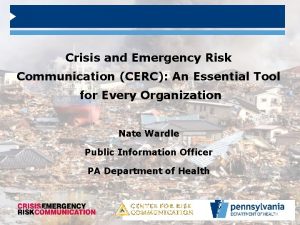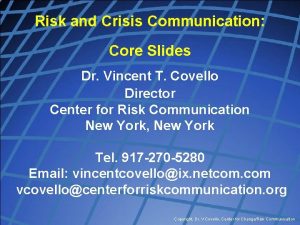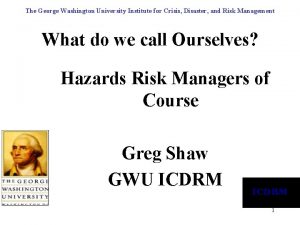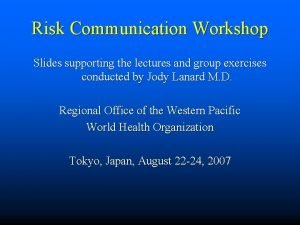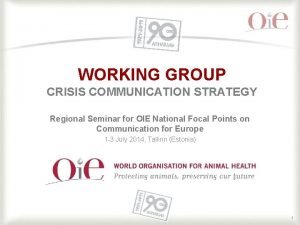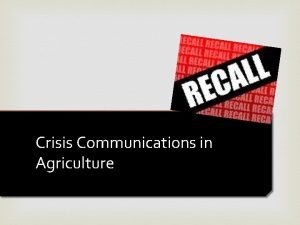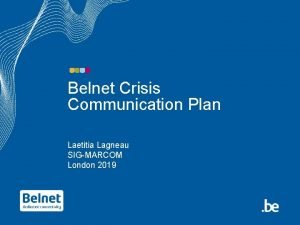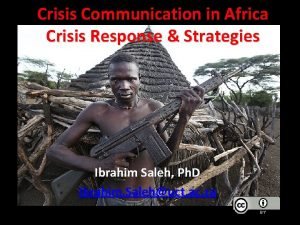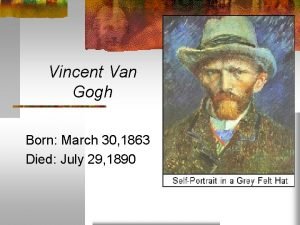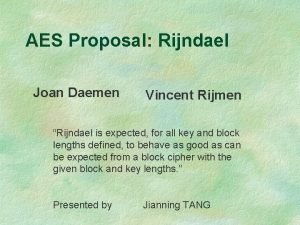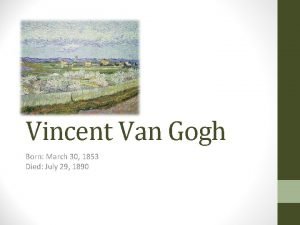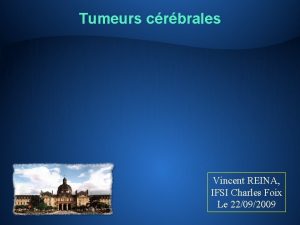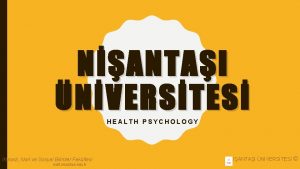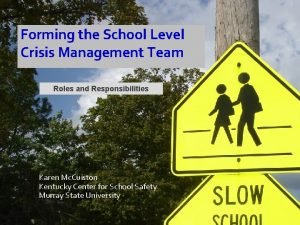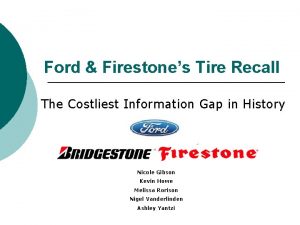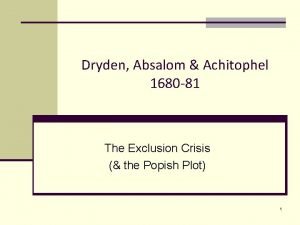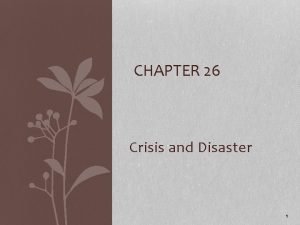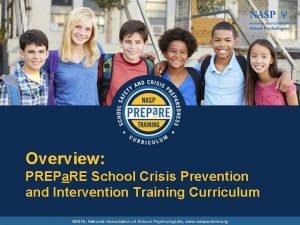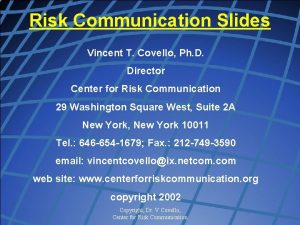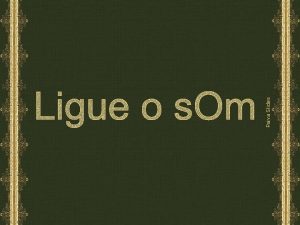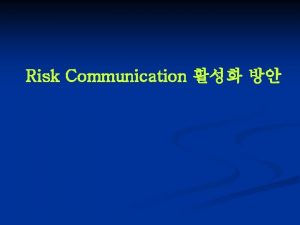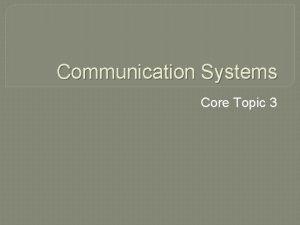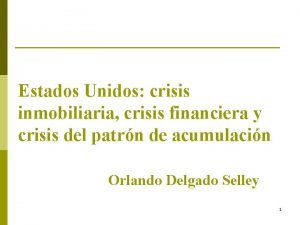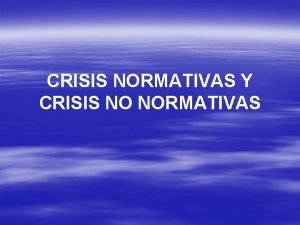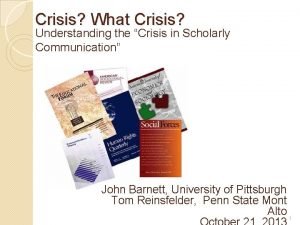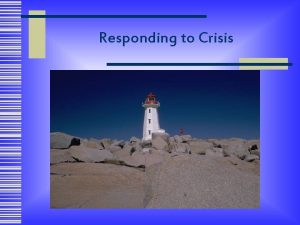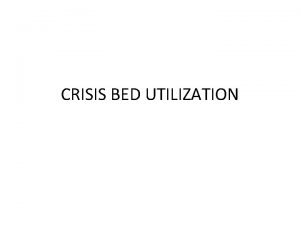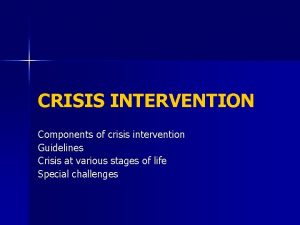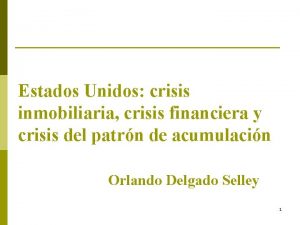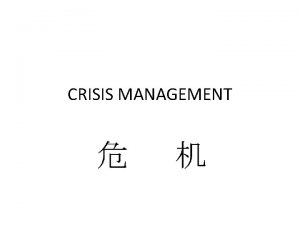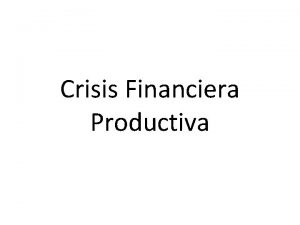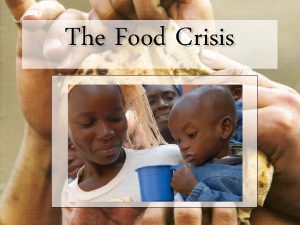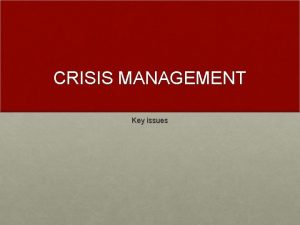Risk and Crisis Communication Core Slides Dr Vincent



















































- Slides: 51

Risk and Crisis Communication: Core Slides Dr. Vincent T. Covello Director Center for Risk Communication New York, New York Tel. 917 -270 -5280 Email: vincentcovello@ix. netcom. com vcovello@centerforriskcommunication. org Copyright, Dr. V Covello, Center for Change/Risk Communication

Risk Communication: Short Definition Risk: “a threat to that which we value. ” Risk Communication: “the exchange of information about risks. ” Copyright, Dr. V Covello, Center for Change/Risk Communication

Research Based Resources • 8000 Articles in Peer Reviewed Scientific Journals • 2000 Books Copyright, Dr. V Covello, Center for Change/Risk Communication

Risk Communication Goals • enhance knowledge and understanding • build trust and credibility • encourage appropriate behaviors and levels of concern Copyright, Dr. V Covello, Center for Change/Risk Communication

Risk and Crisis Communication: Core Templates • • CCO Template 27/9/3 Template Primacy/Recency Template 1 N=3 P Template APP Template AGL-4 Template IDK Template Copyright, Dr. V Covello, Center for Change/Risk Communication

Risk Communication: Resource Materials “Effective Media Communication During Public Health Emergencies: A World Health Organization Handbook, ” Authors: Dr. R. Hyer and Dr. V. Covello World Health Organization, United Nations Headquarters, Geneva (2007)) (Google: “Effective Media Communication”) Copyright, Dr. V Covello, Center for Change/Risk Communication

Risk Communication: Core Concepts When people are stressed or concerned, they: • …want to know that you care before they care what you know. • …have difficulty hearing, understanding, and remembering information. • …focus most on what they hear first and last. Copyright, Dr. V Covello, Center for Change/Risk Communication

Risk Communication Templates • CCO (Compassion, Conviction, Optimism) • Rule of 3 (27/9/3) (27 words, 9 seconds, 3 Messages) • Primacy/Recency (First Impressions; First and Last; Beginnings and Endings) Copyright, Dr. V Covello, Center for Change/Risk Communication

Risk Communication Templates • CCO (Compassion, Conviction, Optimism) • 27/9/3 (Rule of 3) (27 words, 9 seconds, 3 Messages) • Primacy/Recency (First Impressions; First and Last; Beginnings and Endings) Copyright, Dr. V Covello, Center for Change/Risk Communication

Risk Communication Templates CCO (Compassion, Conviction, Optimism) Copyright, Dr. V Covello, Center for Change/Risk Communication

Trust Determination: High Stress Situations Listening/ Caring/ Empathy/Compassion 50% Competence/ All Expertise Other Factors 15 -20% Honesty/ Openness 15 -20% Assessed in first 9 -30 seconds

Trust Factors: Low Stress Situations All Others 15 -20% Competence/ Expertise: 80 -85% Copyright, Dr. V Covello, Center for Change/Risk Communication

Risk Communication Templates • CCO (Compassion, Conviction, Optimism) • 27/9/3 (Rule of 3) (27 words, 9 seconds, 3 Messages) • Primacy/Recency (First Impressions; First and Last; Beginnings and Endings) Copyright, Dr. V Covello, Center for Change/Risk Communication

Risk Communication Templates 27/9/3 (Rule of 3) (27 words, 9 seconds, 3 Messages) Copyright, Dr. V Covello, Center for Change/Risk Communication

Mental Noise (Attention Span) 0 20% 100 Mental noise can reduce the ability to process communication up to 80% Contact: Centerfor. Risk. Communication. org Copyright, Dr. V Covello, Center for Change/Risk Communication

Risk Communication: Attention Span Research “The Magic Number Seven, Plus or Minus Two: Some Limits on Our Capacity for Processing Information” George A. Miller (Department of Psychology, Princeton University) The Psychological Review, 1956, vol. 63, pp. 81 -97

Risk Communication: Attention Span Research “The Magic Number Three, Plus or Minus Two: Some Limits on Our Capacity for Receiving, Processing, and Remembering Information in High Stress Situations”

Message Map Key Message 1 9 words on average Supporting Info. 1. 1 Supporting Info. . 1. 2 Stakeholder Question or Concern: Key Message 2 9 words on average Supporting Info. 2. 1 Supporting Info. 2. 2 Key Message 3 9 words on average Supporting Info. 3. 1 Supporting Info. 3. 2 : Supporting Info. 1. 3 Supporting Info. 2. 3 Supporting Info. 3. 3

Key Word Message Map West Nile Virus Map Key Message “Remove Standing Water” “Wear Protective Clothing” 1. 1 1. 2 1. 3 Unattended swimming pools Flower Pots/Bird Baths Cup of Water Key Message “Use Insect Repellent” 2. 1 Long Sleeves 3. 1 2. 2 Long Pants 3. 2 2. 3 Dusk and Dawn : 3. 3 DEET 23% Medical Research Copyright, Dr. V Covello, Center for Change/Risk Communication

Risk Communication Templates • CCO (Compassion, Conviction, Optimism) • 27/9/3 (Rule of 3) (27 words, 9 seconds, 3 Messages) • Primacy/Recency (First Impressions; First and Last; Beginnings and Endings) Copyright, Dr. V Covello, Center for Change/Risk Communication

Risk Communication Templates Primacy/Recency (First Impressions; First and Last; Beginnings and Endings) Copyright, Dr. V Covello, Center for Change/Risk Communication

Primacy/Recency Template • Low Stress Situations: Brain processes information based on linear order (e. g. , 1, 2, 3) • High Stress Situations: Brain processes information based on primacy/recency (e. g. , 1, 3, 2) Copyright, Dr. V Covello, Center for Change/Risk Communication

Risk Communication Templates • CCO • 27/9/3 (Rule of 3) • Primacy/Recency ======= • 1 N=3 P (1 Negative equals a minimum of 3 Positives) Copyright, Dr. V Covello, Center for Change/Risk Communication

1 N=3 P Template ==== 1 N (Negative) Equals 3 P (Positives) Template “When people are stressed and upset, they typically focus more on the negative than on the positive. ” (Negative Dominance Principle) Copyright, Dr. V Covello, Center for Change/Risk Communication

Risk Communication Templates • CCO • 27/9/3 (Rule of 3) • Primacy/Recency) • 1 N=3 P ===== • APP (Anticipation, Preparation, Practice) Copyright, Dr. V Covello, Center for Change/Risk Communication

Seven Step Risk Communication APP Strategy 1. Identify a risk communication issue or scenario 2. Identify key stakeholders/target audiences 3. Identify potential questions or concerns 4. Develop key messages using message mapping and risk communication template tools 5. Develop supporting information for key messages 6. Test and practice messages 7. Deliver messages through appropriate communication channels Copyright, Dr. V Covello, Center for Change/Risk Communication

Stakeholder Predictability “ 50 Most Frequently Asked Questions by Terminally Ill Patients”

Stakeholder Predictability • • • “ 77 Most Frequently Asked Questions by Journalists in a Disaster” (Handout) “ 65 Most Frequently Asked Questions about Bird Flu and Pandemic Influenza” (google: “pandemicflu. gov, message maps”) 200 Most Frequently Asked Questions about Water Contamination (go to: www. epa. gov/nhsrc)

Challenge Questions False Allegation/False Negative Questions • Guarantee Questions • What If (e. g. , Worst Case Scenario) Questions ====== • Blame/Accountability Questions • Yes/No Questions • Copyright, Dr. V Covello, Center for Change/Risk Communication

Risk and Crisis Communication: Core Templates • CCO Template • 27/9/3 Template • Primacy/Recency Template • 1 N=3 P Template • APP Template ======= • AGL-4 Template Copyright, Dr. V Covello, Center for Change/Risk Communication

AGL-4 Template ======= AGL (Average Grade Level) Minus 4 (Four Grade Levels) Template “When people are stressed and upset, they typically process information at four grade levels below their average grade level. ” Copyright, Dr. V Covello, Center for Change/Risk Communication

AGL-4 Shift • Low Stress Situations: Brain processes information at AGL (average grade level) • High Stress Situations: Brain processes information at AGL-4 (average grade level minus 4 grade levels) Copyright, Dr. V Covello, Center for Change/Risk Communication

Commonly used acronyms in environmental clean-up: LUST RAGS BRA RC LULU CLEAN FONSI REC NOEL RPM CCR IRA Copyright, Dr. V Covello, Center for Change/Risk Communication

Examples… TRANSLATION ? ? ? “This change will allow us to better leverage our talent base in an area where developmental roles are under way and strategically focuses us toward the upcoming system transition where systems literacy and accuracy will be essential to maintain and to further improve service levels to our customer base going forward. " Copyright, Dr. V Covello, Center for Change/Risk Communication

Risk Communication: Core Templates • CCO Template • 27/9/3 Template • Primacy/Recency Template • 1 N=3 P Template • APP Template • AGL-4 Template ======= • IDK Template Copyright, Dr. V Covello, Center for Change/Risk Communication

I. D. K. (I Don’t Know) Template • Say: “you don’t know”/ “can’t answer”/wish you could answer” (Optional: Give the reason why you don’t know or can’t answer the question) • Indicate follow up • Bridge to what you can say about the issue Copyright, Dr. V Covello, Center for Change/Risk Communication

Risk Communication: Core Templates • • • CCO Template 27/9/3 Template Primacy/Recency Template 1 N=3 P Template APP Template (Anticipate, Prepare, Practice) • AGL-4 Template • IDK Template Copyright, Dr. V Covello, Center for Change/Risk Communication

Risk Communication: Advanced Templates • • TBC KDG … … … Copyright, Dr. V Covello, Center for Change/Risk Communication

TBC Template (Trust, Benefits, Control) Key Message 1: Trust Message Key Message 2: Benefits/Fairness Message Key Message 3: Control Message Copyright, Dr. V Covello, Center for Change/Risk Communication

Fear Factors Lower Concern/Fear 1. Trustworthy sources Higher Concern/Fear 1. Untrustworthy sources 2. Large benefits/ fair/avoidance of harm 2. Few or unclear benefits/unfair 3. Under one’s control 3. Controlled by others Copyright, Dr. V Covello, Center for Change/Risk Communication

Fear Factors Lower Concern/Fear Higher Concern/Fear 1. Trustworthy sources 2. Large benefits 3. Under one’s control 4. Voluntary 5. Fair 6. Natural origin 7. Children not victims Untrustworthy sources Few or unclear benefits Controlled by others Involuntary Unfair Human origin Children as victims Copyright, Dr. V Covello, Center for Change/Risk Communication

Perception/Fear/ Emotional Response Factors • Trust • Listening/Caring • Competence/Expertise • Honesty/Transparency • Benefits/Fairness • Societal • Community • Personal • Control • Choice • Voice • Knowledge (e. g. things for people to do) Copyright, Dr. V Covello, Center for Change/Risk Communication

Risk Perceptions “That which is perceived as real in its consequences. ” Copyright, Dr. V Covello, Center for Change/Risk Communication

“Facts about risk (risk data and statistics) play little or no role in determining public perceptions and concerns about risks. ” Copyright, Dr. V Covello, Center for Change/Risk Communication

Credibility Ladder: Environmental Health Most Least • • • Citizen advisory panels Nurses and physicians Safety/emergency response professionals Professors/educators Media Environmental/advocacy groups Industry Federal government Consultants from “for-profit” firms Copyright, Dr. V Covello, Center for Change/Risk Communication

Credibility Transference “A lower credible source takes on the credibility of the highest credible source that agrees with its position on an issue. ” Copyright, Dr. V Covello, Center for Change/Risk Communication

Credibility Reversal “When a lower source attacks the credibility of a higher source, the lower source loses further credibility. The only information source that can effectively attack the credibility of another source is one of equal or higher credibility. ” Copyright, Dr. V Covello, Center for Change/Risk Communication

KDG Template (Overarching Message Map) (Know, Do, Go) Key Message 1: What is most important for people to know Key Message 2: What is the most important thing you are doing or what is most important for people to do (or not do) Key Message 3: Where can people go to get credible information Copyright, Dr. V Covello, Center for Change/Risk Communication

Psychological First Aid Critical Messages: Provide people a sense of: • • • Hope Self- and community efficacy Safety Calm Connectedness “Five Essential Elements of Immediate and Mid. Term Mass Trauma Intervention: Empirical Evidence, ” Psychiatry, 70(4): 2007 Authors: Steven Hobfoll et. al. Copyright, Dr. V Covello, Center for Change/Risk Communication

Risk Communication Resource Materials • P. Ekman, “Telling Lies: Clues to Deception” (see also P. Ekman, “Emotions Revealed”) • D. Morris, “Body Talk: A Dictionary of Human Gestures” • M. Gladwell, “Blink” Copyright, Dr. V Covello, Center for Change/Risk Communication

Risk Communication: Key Messages • Risk communication is a sciencebased discipline • Risk communication is consistent with the way people think about threats • Risk communication helps us better prepare for high concern situations Copyright, Dr. V Covello, Center for Change/Risk Communication
 Crisis and emergency risk communication
Crisis and emergency risk communication Vincent covello risk communication
Vincent covello risk communication Liquidity measures
Liquidity measures Myasthenic crisis vs cholinergic crisis
Myasthenic crisis vs cholinergic crisis A small child slides down the four frictionless slides
A small child slides down the four frictionless slides A spring loaded gun shoots a plastic ball
A spring loaded gun shoots a plastic ball Institute for crisis disaster and risk management
Institute for crisis disaster and risk management Crisis text line ladder up risk assessment
Crisis text line ladder up risk assessment Inner core and outer core
Inner core and outer core The crust the mantle and the core
The crust the mantle and the core Purpose of paradox
Purpose of paradox Risk workshop slides
Risk workshop slides Crisis communications working group
Crisis communications working group Crisis communications lecture
Crisis communications lecture Laetitia lagneau
Laetitia lagneau Crisis communication skills
Crisis communication skills Public response
Public response Crust outer core inner core mantle
Crust outer core inner core mantle Residual risk and secondary risk pmp
Residual risk and secondary risk pmp Business vs financial risk
Business vs financial risk Attributable risk formula
Attributable risk formula Relative risk calculation
Relative risk calculation Business communication lecture slides
Business communication lecture slides Risk projection attempts to rate each risk in two ways
Risk projection attempts to rate each risk in two ways Risk avoidance insurance
Risk avoidance insurance Absolute risk vs relative risk
Absolute risk vs relative risk Inherent risk vs control risk
Inherent risk vs control risk Absolute risk vs relative risk
Absolute risk vs relative risk Activity sheet 2 stock market calculations answer key
Activity sheet 2 stock market calculations answer key Medium-term risk examples
Medium-term risk examples Risk financing transfer adalah
Risk financing transfer adalah The biggest risk is not taking any risks
The biggest risk is not taking any risks Key risk indicators for vendor management
Key risk indicators for vendor management Ir x cr x dr
Ir x cr x dr Risk map risk management
Risk map risk management What is oral communication and written communication
What is oral communication and written communication Definition of oral communication
Definition of oral communication Parallel and serial communication difference
Parallel and serial communication difference Vincent van gogh born and died
Vincent van gogh born and died Aes proposal: rijndael
Aes proposal: rijndael Vincent van gogh nationality
Vincent van gogh nationality Ventriculocysternostomie
Ventriculocysternostomie Gauguin's chair
Gauguin's chair Moos and schaefer 1984 crisis theory
Moos and schaefer 1984 crisis theory Crisis management team composition
Crisis management team composition Ford and firestone crisis management
Ford and firestone crisis management Exclusion crisis in absalom and achitophel
Exclusion crisis in absalom and achitophel Chapter 26 crisis and disaster
Chapter 26 crisis and disaster Crisis and absolutism in europe
Crisis and absolutism in europe Pros and cons of acting on crisis urges
Pros and cons of acting on crisis urges School crisis prevention and intervention
School crisis prevention and intervention Hybrid model of crisis intervention
Hybrid model of crisis intervention
